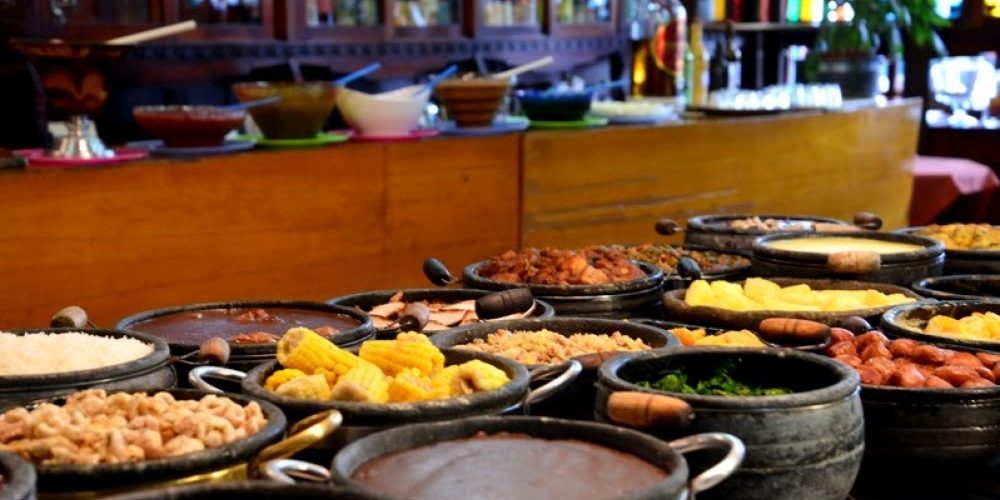Edible history
Each region of the country has its own history often manifested in unique and fascinating gastronomic traditions. Brazilian cuisine has a clear African, indigenous and European influence, enriching itself in many different ways, while expanding and merging with the regional customs of this vast territory. The ingredients, forms of preparation, recipes and food consumed are the sum of geographical, historical, biological and cultural factors. That is why getting to know and experiencing the gastronomy of a region is a delicious and decisive way to really understand the place visited and its inhabitants.
One of Brazil’s emblematic dishes is feijoada, a stew made with black beans, dried pork meat and served with rice and oranges and sprinkled with fried yucca flour, better known as farofa. This dish comes from African slaves, – they used to eat it every day -, with some variations depending on the context. Today, most Brazilians consume rice and feijao daily at lunchtime, accompanying all kinds of meats, tubers and vegetables. Other typical dishes of African influence are acarajé, caruru, vatapá and moqueca, which are consumed more frequently in northeastern Brazil and have been given prominence in the gastronomic tradition of the region.
Cassava or yucca and corn are of great importance in the culinary of the country and are used in many ways to prepare all kinds of recipes: tacacá, tucupi, canjica and pamonha are indigenous legacies acquired by a large part of the population. With its ingredients and techniques, indigenous cuisine would form the basis of Brazilian cuisine and give it its authenticity, with cassava as a national ingredient, and included in most dishes. Among them is the barreado, typical of the coast of Paraná, whose main ingredients are meat and bacon low heat cooked in about 20 hours in a covered clay pot. To this, they add a mixture of cassava flour, ashes and hot water. The way to cook all kinds of meat and fish, the famous tapioca and a variety of exotic fruits such as açai and cupuaçu are part of the native heritage for immigrants who came to populate the territory. Portuguese, Italians, Germans, Spaniards, Syrian-Lebanese, Japanese, etc., also brought their customs, fusing and adapting their food with regional ingredients and sharing their favorite dishes such as pizza, risotto, polenta and the strong taste for the cheese, until passing it to the locals.
Whatever its origin, gastronomy in Brazil is an impossible topic to ignore, since Brazilians themselves value it and keep it as a treasure. This is evident in any place of the country, when you visit towns, cities and restaurants. On the street it’s so easy to see samples of this cult of culture through food, as each corner brings an opportunity to discover its flavors and textures: acarajé, coxinhas, pasteis, churrasco, pamonha, tapioca and a thousand other things are offered in small street food stalls anywhere you go. Even when you start a spontaneous conversation with locals, most likely the food topic will end up popping up with some recommendation, dishes you must try, and you’ll probably get invited to share the most representative drink in the country, the caipirinha!
The taste of traveling Brazil
One of the most recognized Brazilian states for its gastronomic culture is Minas Gerais. Here, you can have a journey full of knowledge and flavor amid wonderful landscapes and the best accommodations in each place. It is the perfect trip destination if you enjoy the interaction between history, art and gastronomy to awaken the intellect, the inspiration and the senses at the same time. Through the beautiful colonial villages spread among the green and lush mountains of the region, Minas Gerais reveals its secrets through cobbled streets, old houses, churches, museums, monuments and the most representative restaurants of Brazilian cuisine.
What is your preference? Milk sweet, guava sweet, fine cheeses, artisan popsicles, fruit jellies and the famous alembic cachaza are some of the delights that make part of this destination’s menu.

In the State of Pará, nature is rich in herbs, fruits, flavors and aromas. It is the reason why its cuisine is considered one of the most typical and surprising in Brazil, placing it in the national and international market of gastronomic tourism. With its culture, cuisine & wildlife, tropical Pará offers a wonderful context to taste the distinctive flavors of the exotic cuisine of Ilha de Marajó, an amazing delight while you meet passionate locals who keep culinary traditions alive. Be sure to discover some secrets within their expert knowledge of local products and recipes! The views, the smells, the flavors and the sensations of this extraordinary place, will leave you with new and, more importantly, mouthwatering memories.

And for dessert: always chocolate! There is a great beach in Brazil called the Cocoa Coast and it is not just a romantic name. The Cocoa Coast of Bahia is the key to discovering the secrets of the world’s favorite sweet, with a fascinating cultural heritage and a sublime Atlantic coast. Here you can have an immersive experience visiting local farms to witness and be part of the first-hand cocoa production process, from planting to eating. You can enjoy a tutorial on the craftsmanship of handmade cocoa, visit an old fazenda that is involved in both the cultivation and multiple environmental initiatives aimed at protecting the forest, while discovering the beauty of nature in a place flooded with crystalline rivers, nature trails, great biodiversity and countless outdoor activities. The perfect way to balance any overindulgence with all this irresistible and inescapable chocolate!
Learn new recipes in wonderful destinations
Each place has its culinary secrets, aromas and flavors that surprise whoever comes to visit. And those who wish to learn a little more can do so with the help of local experts. How about a cooking class in beautiful Paraty, in Rio de Janeiro or in Salvador to take home new typical Brazilian recipes? It is a wonderful opportunity to pamper the palate while talking with a local about Brazilian and world recipes, culture, and increasing the repertoire of culinary tricks and secrets.
There are also very interesting activities in Foz do Iguacu, which offer a gastronomic journey through the history of Brazilian cuisine, its geography and its villages, from before the arrival of Europeans to the present day. A relaxed party full of flavors, aromas and stories that can take you to the depths of Brazilian culture, from the Amazon through the northeast coast to the Sertão.
Food to discover, learn and enjoy
Wherever we are, wherever we go, we have to eat. It is so interesting when food also shows you its history, its why and how. Each dinner, each dish, is a small journey within the great journey. That is why gastronomic experiences are so deep and that is why you are invited to live adventures full of cultural wealth and sensory delight in Brazil.








